Best Long Term Trading Strategy for Forex in 5 Steps

There are many reasons why I believe a long-term trading strategy for Forex will set you up for success. More so than using smaller time frames to trade, and I will get into several of those reasons within this article.
I lay out a few of those reasons in a light-hearted tone in my Scalp vs Swing Article. This article has gotten a lot of attention. First, I want to clarify that when I say “Long Term” I mean, at least, looking at the daily charts. Ideally, a long-term Forex trading strategy has many parts that all come back to user analysis.
Before we begin, we want to welcome you to Trading Strategy Guides. You have come to the right place to learn everything you need to become successful in Forex Trading. Here are a few articles that may help you get up to speed if you’re a new Forex Trader:
- What Is Trading: Beginner’s Guide To Financial Markets
- Forex Trading For Beginners
- Day Trading For Beginners
- Prop Trading For Beginners
Thanks for your patience, let’s continue learning the best long-term trading strategy!
Table of Contents
Introduction: Long-Term Trading Strategy for Forex
I believe that one of the big issues with Forex traders today is that they are so caught up in short-term trading and scalping. Which, I really do have a hard time believing traders can be profitable (there are some exceptions). They don’t even recognize what long-term trading is.
I have had many traders say something like this to me, “I want to begin looking at the best long-term forex trading strategy because scalping has not worked for me. I am now using a long-term strategy, trading the hourly charts.”
I think the above statement is one of the issues with Forex Traders today. And why so many have a lot of trouble being profitable. Learning this type of trading is one way you can learn how to become a successful Forex trader. One thing you should consider is whether you want to execute a long-term trading strategy or focus on a short-term trading strategy.
For some reason, the majority of traders—especially beginners—are so bent on scalping. They don’t even have a realistic idea of what long-term trading is. I know my friend, Zaheer, will agree with me on this one.
Again, when referring to, “Long Term Trading,” I mean using Weekly charts (and Monthly) as your guide to set up potentials and targets. Then, perhaps, use a lower time frame to actually execute the trade for more precision.
Make sure to also check out our guide to Forex trading for beginners!
Before I get into the actual strategy, I want to dig a little more into why the right perspective is important when it comes to trading long-term strategies. I know that many of you only care about the actual strategy guidelines, but I believe that the following information about perspective and a holistic approach is more important than the strategy guidelines. Comment below if you agree/disagree with me on that. You can also read a million USD forex strategy.
Long-Term Trading Strategy 4-Hour Chart
As an example of how this “Short Term Mindset” can get you into trouble, let’s take a look at the EUR/USD.
Someone looking at the EUR/USD on a 4HR chart would see something like this:
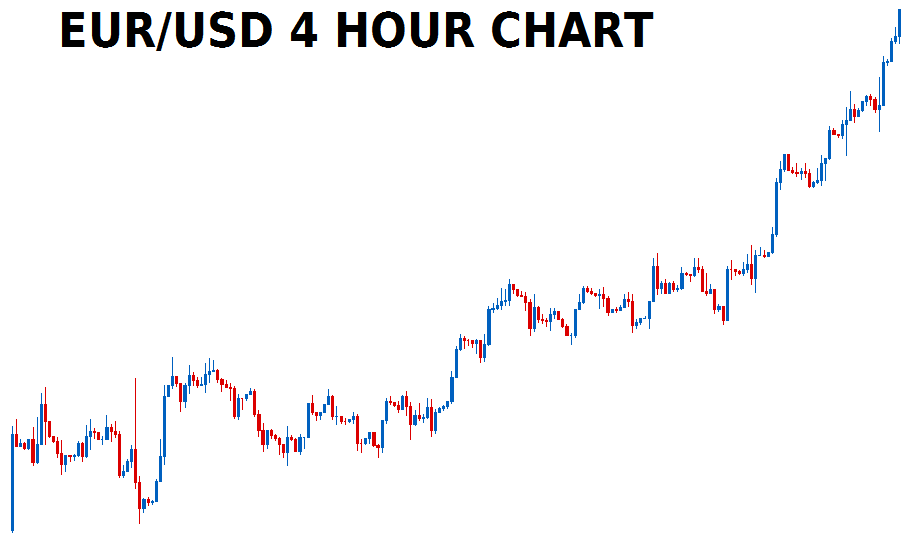
In the above chart, you see that there is a lot of bullish momentum moving toward higher highs. From this perspective, it looks as though all bullish continuation set-ups will be great entries.
Long-Term Trading Strategy Weekly Chart
However, a longer-term view of the EUR/USD at the same exact time tells a different story:

You can see by looking at the Weekly chart, that the EUR/USD is in a long-term forex trading strategy downtrend. You’ll notice the bullish rally on the 4HR chart is just a pull-back rather than a raging trend as it appeared before. Also, read the weekly trading strategy that will keep you sane.
Not only is it a pullback, but it is a pullback heading into unsuspected resistance. It is unsuspected if you only look at the 4HR and don’t realize what is going on long-term. If you want to earn good revenue from our long-term trading strategy, I recommend you try looking into prop firm trading.
If we move a little bit ahead in time, you can see a bearish bounce off the resistance level. To the trader viewing only the 4HR chart, this may look like a great time to buy again in anticipation of a Bullish trend continuation. One of the best time frames for a great Long term trading strategy is a multi-time frame analysis.

What the 4HR trader may not realize is that this is not a pullback of the 4HR trend. Rather, it is a continuation of the Weekly trend. Where the long-term trader sees obvious Bearish continuation potential, the short-term trader thinks this is “just a pullback.”
To the 4HR trader, this looks like an unexpected major reversal in the market. To a long term trader, it is an obvious and expected continuation of market flow. It looks like this in the Weekly view:
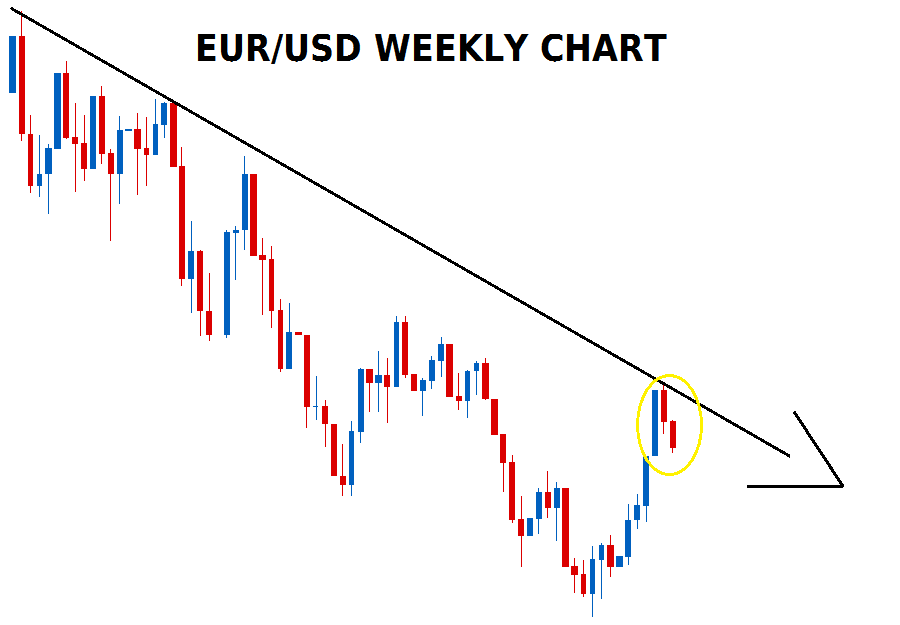
This is why it is so important to have a long-term view of the market. Especially if you are going to call yourself a long-term trader. Again, so many people looking at 4HR charts think they are long-term traders. But they are ignoring the real long-term time frames. Ignoring this can get you into big trouble, just like in this real-life example. Those two bearish weekly bars you see would crush someone trying to take long positions on the 4-Hour chart. Yet they are just part of the flow in the Weekly view.
Now, I am not saying that you cannot trade profitably on the 4HR charts. I am saying that it is very difficult to make consistently profitable trades when you do not have a good perspective of the market’s longer-term movement. Especially when trying to trade an intermediate time frame like the 1 or 4-hour time frames.
With that said, let’s talk about my long term strategy for traders who want to be profitable and consistent! ????
One major note about this strategy is that you must be disciplined if you want to succeed. Yes, you need to be disciplined with all strategies to expect success. But in particular, if you want to trade a long-term strategy effectively, you must control your emotions and desire to, “get” into the market.
One of the biggest mistakes that unprofitable traders make is over-trading and over-managing their trades. As human beings, we have a desire for action and involvement. This tends to cause us to always want to have a trade open or always want to manipulate the trades we do have open. I can promise you that this will only lead to less and less profitability.
If you want to be successful using the long-term strategy that I am presenting to you, you must accept that there will not be a ton of entries. Which is a good thing, in my opinion. Also, accept that there will be no need to “jump in” to the open trade and manage it. Also, read about the best forex indicators.
Here is how the strategy works
1. Long-Term Trading Strategy: Start With Monthly and Weekly charts.
Look for trends on these longer-term charts that have good momentum in the respected direction. Something like this:
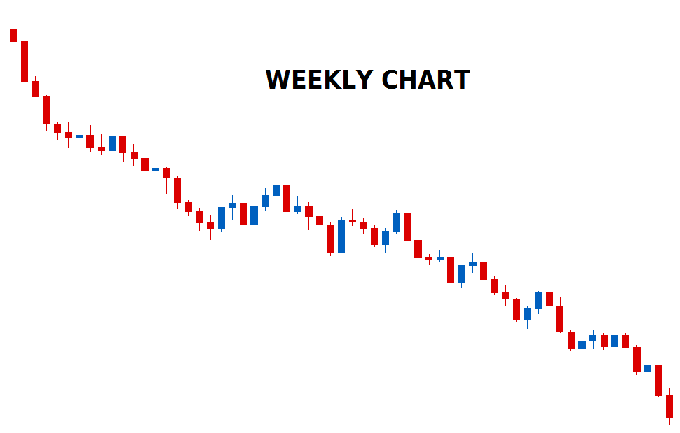
Identify the direction of the trend (bear or bull). Make a note to only look for entries in the direction of that trend (for instance, if it is a bullish trend, look for buys).
2. Long Term Trading Strategy Daily Chart and draw a Fibonacci Retracement from the current high to current low (or the other way around).
Here is how to draw a Fib Level for those that don’t know:
3. Look for pullbacks on the Daily time frame that are approaching the 38.2, 50.0, or 61.8 Fib Levels.
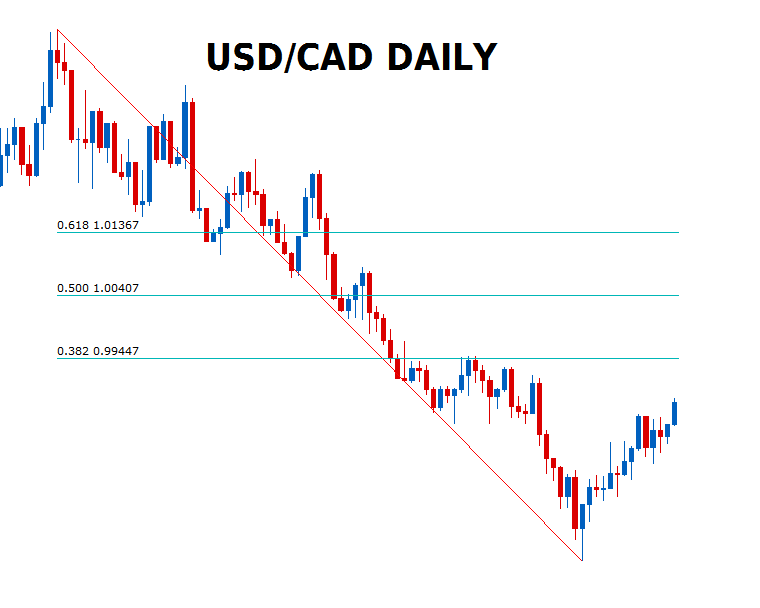
If the price is getting close to one of those 3 key fib levels, be prepared to make an entry.
4. Look for Candlestick Entry after Fib Level is Tested (touched by Price).
As soon as price touches a weekly Fib level, you are now in the “waiting for signal” mode. In other words, the criteria has lined up for you to make a trade, now all you need is the signal to confirm your forecast. As I Casey Stubbs look at this I truly believe that this is best strategy for long term trading that you can learn. I recommend you test it out and then let us know in the comments on how it works for you.
For this strategy, the signal is a momentum daily bar in the direction of our long term trend. An ideal daily signal candle will have a tail that has tested (pierced through) the Fib level, but then reversed back into the direction of the trend:
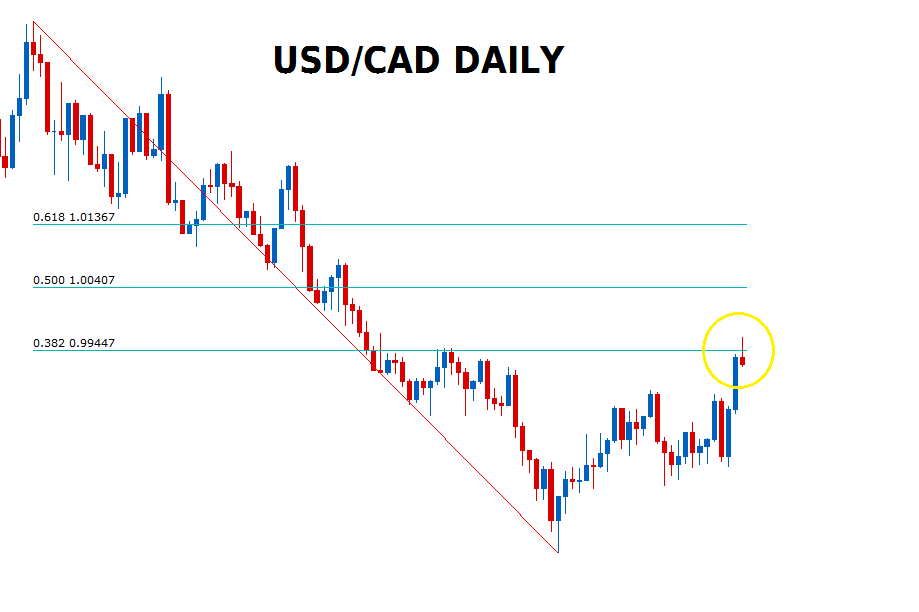
5. Take the entry. Place your stop and target. This is how a Long Term Trading Strategy comes to completion.
Here’s how…
6. Wait… then win or lose.
Just like I showed you in the video above; some trades win and some lose.
Don’t try to manage the trade or get fancy, just trust the strategy and let the trade be a winner or a loser. Trading is all about Math—a good strategy has winners and losers, but at the end of the year, the winners out-weigh the loser. They will in this strategy if you follow it with discipline! To help with the math, try the forex trading position size calculator tool.
Frequently Asked Questions:
We like to make this content as useful as possible, so we have added some frequently asked questions.
Which strategy is best for long-term investment?
A long-term investment strategy that emphasizes diversification, regular contributions, and patience is considered to be one of the best. This strategy involves investing in a mix of assets such as stocks, bonds, and real estate and regularly contributing to the portfolio over time.
This helps to reduce risk by spreading investments across different asset classes and dollar-cost averaging, which helps to reduce the impact of market volatility on the portfolio. Additionally, a long-term investment strategy should be based on an individual’s goals, risk tolerance, and time horizon. It’s always recommended to consult a financial advisor before making any investment decisions.
What is the most profitable trading strategy?
The most profitable trading strategy varies depending on market conditions, an individual trader’s goals and risk tolerance. However, a strategy that incorporates both technical and fundamental analysis, risk management, and a well-defined plan is often considered to be profitable.
For example, swing trading, which involves holding positions for several days to take advantage of short-term market trends, can be profitable when combined with proper risk management, such as setting stop-loss orders.
Another example is trend following, which involves riding the trend of the market and exiting when the trend reverses, can also be profitable when combined with proper risk management. It is important to note that there is no one-size-fits-all strategy, and what works for one trader may not work for another.
It’s always recommended to backtest and practice the strategy with a demo account before trading with real money.
Is long-term trading profitable?
Long-term trading can be profitable, as it allows traders to take advantage of long-term trends in the market and potentially compound returns over time. However, it’s important to note that long-term trading is not a get-rich-quick scheme and requires patience, discipline, and a well-defined trading plan.
Additionally, a long-term trading strategy should align with an individual trader’s goals, risk tolerance, and trading style. It’s important to diversify the portfolio across different currency pairs and timeframes to reduce risk, and stay up-to-date with economic and political events that may affect currency prices. However, it’s also important to keep in mind that past performance does not guarantee future results, and no trading strategy is foolproof.
What is the 90 rule in trading?
The 90 rule in trading is a long-term trading strategy that involves cutting losses quickly and letting profits run. The rule states that when a trade is entered, a trader should set a stop-loss order at a level that is no more than 90% of their account equity. This helps to limit potential losses and protect the trader’s account from large drawdowns.
Additionally, once a trade is in profit, the trader should use a trailing stop-loss order to lock in profits and let the trade run as long as the market conditions remain favorable. This strategy is based on the principle that it is better to cut small losses quickly and let large gains run, in order to maximize the overall profitability of the trading account.
Hope you guys enjoyed learning one of my favorite long-term strategies. Please leave a comment with any feedback.
Comment if you plan on trying the strategy, or comment if you hate the strategy!
Either way, I’d love to get your feedback!


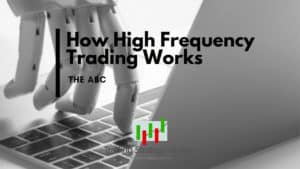




Great stuff Nathan, I have always believed in long term trading and this by far the best strategy I have come across’ I intend to trade this strategy next year on bigger time frames.
Awesome, Anthony! Thanks so much for taking the time to read and even trying the strategy; be sure to let me know how you do using this strategy!
I will try this strategy. Thanks, Nathan.
Hey thanks for reading. Be sure to let me know how you do using this strategy!
Hi Nathan, thanks for this great post
I’m also a great fun of fibo retracement and it’s been working very well for me also. Your strategy confirms that I’m doing something right
Thank you
Gilberto
Hey Gil, that is great! Glad to hear you are having success using the fibs–they can definitely be a great tool if you use them the right way! Thanks so much for reading my article and leaving a comment, I very much appreciate it!
This makes a lot of sense. It is entirely too easy to look only at a single time frame and ignore the larger picture.
Hey Dave, Yeah I agree with you on that. I am definitely guilty of doing that very thing before… for some reason it is tempting to get “caught up” in a smaller time frame–watching the price move–and not realizing that if you take a trade JUST based on that time frame, you may be ignoring the longer term picture. Thanks for the comment, I think you are right on with the issue of ignoring the big picture!
Very nice post. Always thought 4hours was long term. My problem with long term as you presented is the fact that stops and loses are usually greater too. Some people think the market is too volatile and unpredictable for you to stay too long in a trade but I’m sure all will agree your analysis is very correct.
Hey Tony, thanks for reading. I appreciate you taking time out of your day to read my article and leave a comment as well. Yeah, unfortunately, you can’t really have the best of both worlds with high probability long term trades and still manage tight stops, but the best way to be profitable is to understand how to dial down your risk with smaller size trades and remain consistent even after losses. Using a long term strategy, like this one, takes a lot of patience but it can be very profitable if you stay disciplined.
Like the clear video fib strategies.
Thanks for watching/reading and leaving a comment, I appreciate it!
Thanks for the information, I plan to start the new year with longer time frames and I was going to use 4 hour charts. But now I will look at weekly and daily charts more.
Thank you.
Thanks for reading! I am glad this article may serve as a useful piece of information for you. Feel free to re-post here later on and let us know how your strategy is going using these longer time frames.
Thanks for this, I have tried this some on dly & hrly charts and had some success,but needed these s/l & target levels to profit.will work on your longterm trades with this system with patience.Will advise outcome down the road.
Thanks Louis, I appreciate you taking the time to read and also leaving a comment. Let me know how you do using this strategy!
Hi Nathan, I agree with longer time frames and specifically days not hours, minutes or weeks. I my self only trade off day charts, and these are my reasons.
1. Spread eats up a large part of an intraday trade – often 10% or maybe more.
2. The broker is acting against you – he loses if you win, and he wins if you lose. This is in the fine print of all new accounts. A dealing desk will give lower spreads but will actively make you lose.
3. Days are the ‘natural’ time frame for trading, where as hours or minutes or weeks are arbitrary units.
4. Candles were always meant to be on days – from the earliest time in Japan this is how they started.
5. Days means you can plan trades at ease.
I think these are compelling reasons to trade from day charts, so that’s what I do.
Joe
PS. If you are interested, I just look for trends and jump on. I use pairs that naturally tend to trend for long distances (such as the Euro crosses among others EURNZD etc) I use MA8 and MA12. When the MAs are both rising, and the 8 is above the 12, I put a long entry just above the most recent high. I trail along the MA8 until BE, then along the MA12 when it catches up. I raise the stop to below a candle that suggests the trend may have ended (eg a pin bar against my trade). If it isn’t taken out I wait for the MA12 to catch up and keep trailing. (the opposite of all this for shorts) No fib levels used. Pretty successful!
Hey Joe, thanks for the great comment, I really appreciate you putting the time and effort into adding value to this post with a great, informative comment. I don’t believe I have ever heard anyone lay out the reasons for using the daily chart as you did, and that is very interesting..
I would love to learn more about your strategy, Perhaps you could write out a nice explanation of it like I did in this article and we could post it on the blog as a guest post by you. I am sure our readers would love to get your perspective!
Thanks for sharing your strategy, Nathan. It is simple and you explained it very well. It does demonstate that a simple strategy can be very effective and it highlights the importance of patience and money management. One of my major challenges in trading is patience and that can be very costly. I feel a strong urge to trade every time that I switch on my charts (and I know that I am not alone). I am gradually getting comfortable with trading longer term strategies and your reasoning and logic for favouring those give strong evidence that longer term strategies are the way to go.
Hey Mike, glad you enjoyed the article! Yeah, you are definitely NOT alone… I, too, struggle with be tempted to take a trade that does not fit my plan just because it “looks good” at that moment in time, but that is definitely not the profitable way to trade… thanks again for reading and leaving a comment!